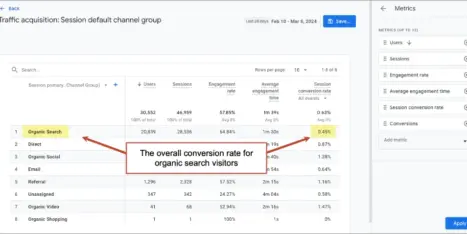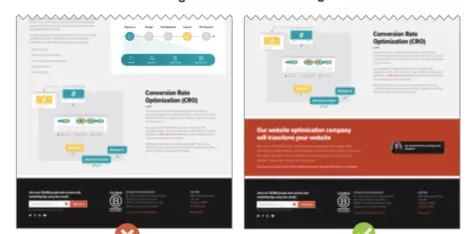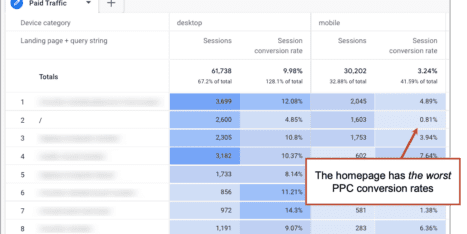Please raise your hand if you’re doing content marketing. Wow, that’s basically everyone here. Awesome.
Now, please keep your hand up if you’re measuring the effectiveness of your content marketing. Ut-oh, why did so many hands go down?
Actually, I believe I know. You’re of the opinion it’s difficult to measure your content marketing efforts. It can be. But it doesn’t have to.
You may have read about various ways to calculate ROI and found them complex, and perhaps, overwhelming. Yeah, me too.
However, avoiding any and all content marketing metrics isn’t wise. You’re essentially denying yourself opportunities to improve—or even, justify—the efforts you’re pouring so much time into.
I can’t accept that. Nor should you. Let’s stick the calculators in the desk drawer and look at ten easy ways to detect if your content is cutting it.
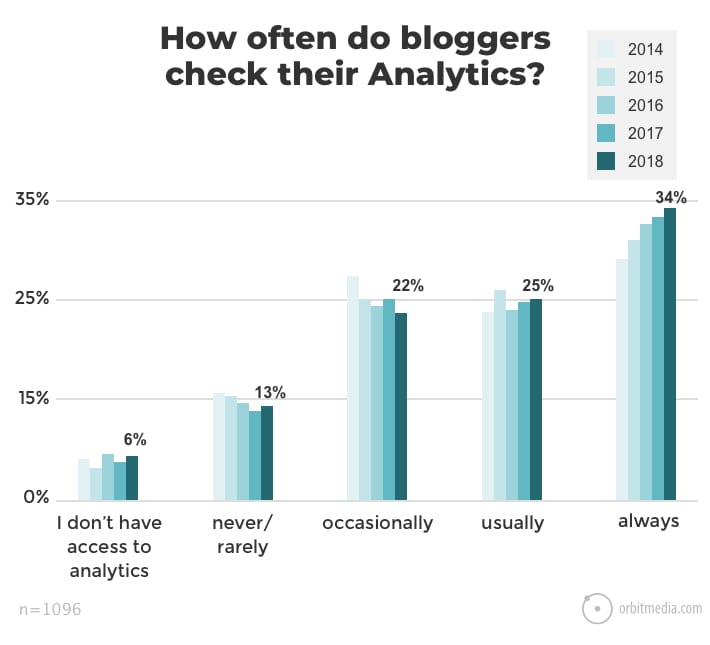
Data collected in our annual survey of bloggers indicates 42% of bloggers don’t consistently check their analytics.
1. Website traffic
While website traffic doesn’t necessarily feed the family, you will starve at the digital marketing table without it.
Use Google Analytics to gauge your past website traffic and up-to-date averages. Select any timeframe you like: years, quarters, months or weeks. Make website traffic a measure you examine often. Monitoring website traffic is a smart and simple way to hold your marketing team or outside vendors accountable.
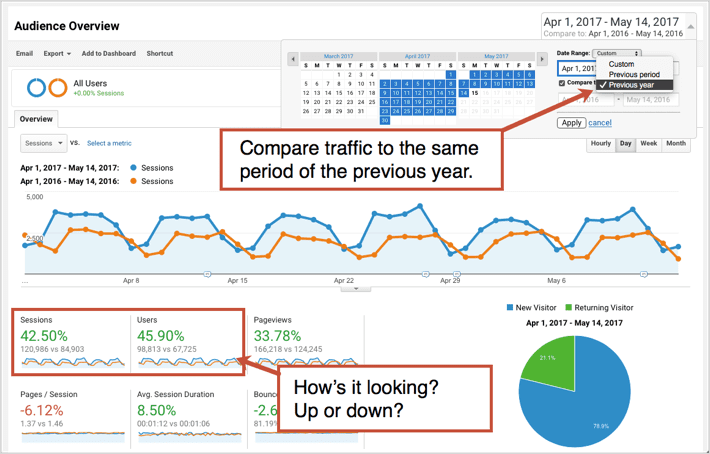
Choose “compare to previous year” to remove seasonality as a factor.
Of course, you can dig deeper. A few clicks into your analytics is all it takes to stratify your traffic by its source or investigate which pages visitors actually visit, but the point of this post is to practice content marketing analytics with the most basic KISS approaches. So observe how much website traffic you get and aim to increase it.
2. Subscriber growth
It’s a rare digital marketing strategy that doesn’t include email marketing. At the risk of sounding like a word nerd, I want to introduce the term disintermediation—because the power of email marketing comes from establishing a direct line of communications with audience members—and without intermediary, er, media.
Like most of the topics we’ll address here, email marketing can be complex or simple. Most marketers now embrace more advanced email techniques and tactics that may be better described as marketing automation. Equipped with a marketing automation platform, you can segment audiences in a variety of ways and measure many variables relative to your content and email marketing.
Never mind all that for now. Your email marketing is likely your most important play for staying top-of mind with prospects, delivering content, and earning trust.
So again, forgo the long list of email marketing metrics you might embrace as you mature and focus first on the growth of your list. Start by recording at least one subscriber headcount (probably total subscribers) and focus on accelerating its growth.
Did your quarter over quarter email subscriber growth measure 3%? What kind of content marketing efforts might it take to double the number?
Whether you’re publishing articles, videos, podcasts, graphics or some combination, in the interest of growing your business, you want to see the number of people who get your newsletters and different types of email announcements get steadily bigger.
3. Search rankings
Content marketers certainly want to drive traffic, leads and sales by way of search, which means search rankings is key. The patterns of search engine users (a.k.a. everybody) clearly demonstrate all glory goes to the brands that achieve page one rankings.
To be atop page one for a search relevant to your business is gold. And sure, some silver and bronze is awarded to the pages listed on the bottom half of the coveted page one. No medals are handed out to the rest of the field that appears on pages 2 to 2,000,000. Such is the cold reality of search.
You can subscribe to tools such as Moz, SEMRush and Ahrefs to continually monitor your rankings, however your best bet for tracking your rankings on the cheap is Google Analytics.
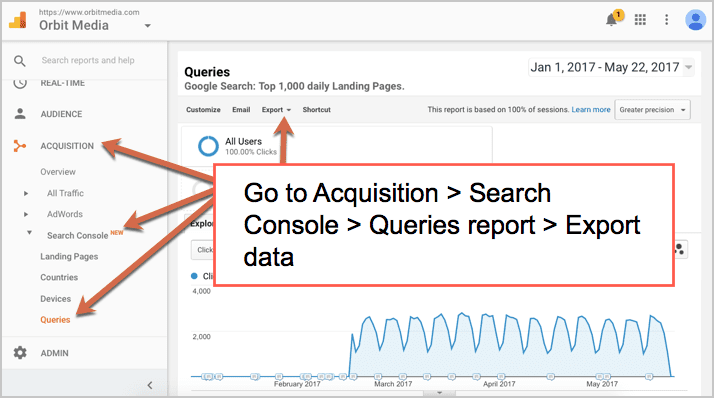
Look at your Acquisition > Search Console > Queries report. The report only shows data for the last three months. Export the data if you want to manually check rank fluctuations over time.
If you’re game for checking your rankings one phrase at a time, this tool from SEOCentro will get the job done.
4. Time
HubSpot claims more than half of website visitors spend less than 15 seconds on a website. You’re unlikely to achieve your objectives if this problem plagues you.
That said, “time” measurements can be slippery, but still significant. Certainly, having the ability to measure them at all gives you a step up on traditional media where you’d have no idea regarding the level of engagement or consumption.
Of course, you want your visitors to spend at least as much time on your site as it takes to consume the content on a single page. But they seldom do. Here’s the challenge…
If you’re in the habit of publishing 60 to 90-second videos, a 60-second visit, or average, is beyond good. However, if instead you generally publish 3,000 word articles, 45-minute webinars, or lengthy podcasts, a 60-second average is disappointing.
Consider your content and its goal. Consider forging benchmarks of where it stands now. Then, consider content metrics related to time-on-page in terms of how it relates to the time it takes to consume the content—and how the numbers compare to each other.

Examine how individual pages perform. Look at the Behavior > Site Content > All Pages report and switch to the comparison view. Select “Ave Time on Page” from the drop down to see time on page data.
Again, we’re not looking for complex formulas. We’re looking for simple benchmarks. Itty-bitty time on page, as a percentage or whole, is counter to what you want. Is your time on page going up? This indicates you’re creating more engaging content.
5. Social media followers
As a metric, social media followers gets a bad rap. Many pundits use the expression “vanity metric” to describe follower count as if the size of your audience is unimportant.
It’s not. While the size of your audience might not track to the growth of your brand, it’s shortsighted to pay it no mind.
Provided you earn an audience organically—rather than purchase followers—seeing your social media follower count increase is an indication the content you share on social channels appeals to people.
Since I’m encouraging you to step into (or step up) your content marketing analytics efforts, I submit a larger audience expands your reach and thus, makes it simpler for you to achieve shares, links, mentions, and other fundamental objectives critical to the success of your content marketing.
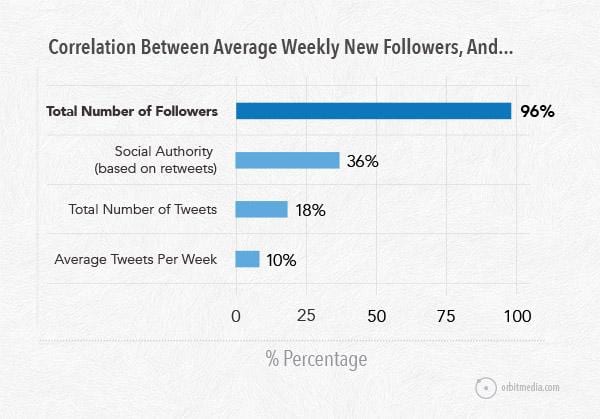
Orbit Media did a study on growing a Twitter audience and drew useful conclusions about what does and doesn’t help.
6. Social media shares
In 2014, Shareaholic reported approximately 30% of website traffic is driven by social media.
However, conversations about social shares also tend to uncork a good bit of debate. See, the process of social sharing is so often automated. Still, I care very much about social shares and if you’re trying to ascertain what content best resonates with you audience, you should too.
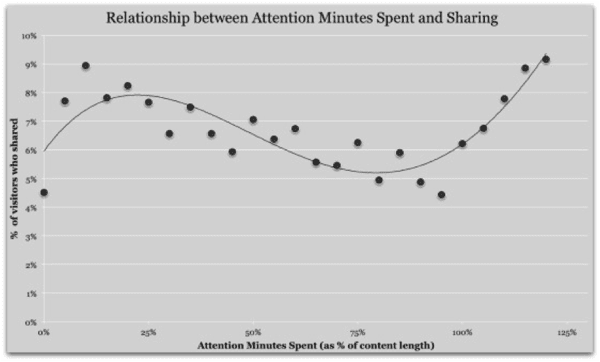
One of the “dark truths” about social media is people share without reading.
Measuring your social shares will help you determine the traction your content gets on social platforms. You can measure:
- Overall social shares
- Shares by social media channel
- The number of social shares each piece of content earns
- The number of website visitors your website earns from social sites
As a result, you’ll gather insights about the types of content to create and which social platforms merit your time.
In a stellar study on the topic on the MarketingLand blog, Mark Traphagen writes:
“A study by Socialbakers shows that the amount of social interactions on a brand’s social media posts correlates with the number of visits to the brand’s website. In other words, when social interactions are high, visits to the corresponding websites tend to go up as well. It appears that when social media users are most engaged with a brand, they are also more likely to visit the brand’s site.”
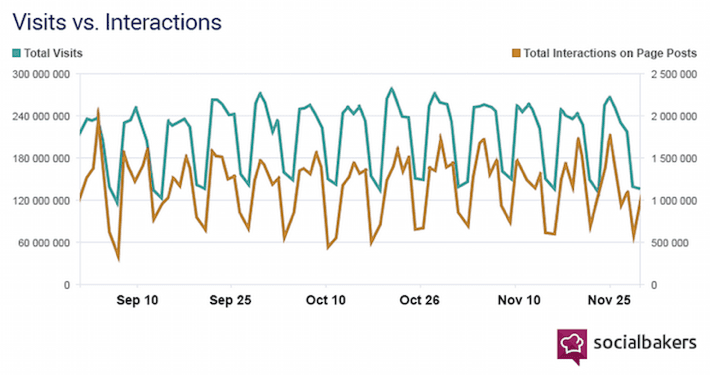
According to Searchmetrics research, there is a 20 percent rank correlation between Facebook signals and organic search ranking.
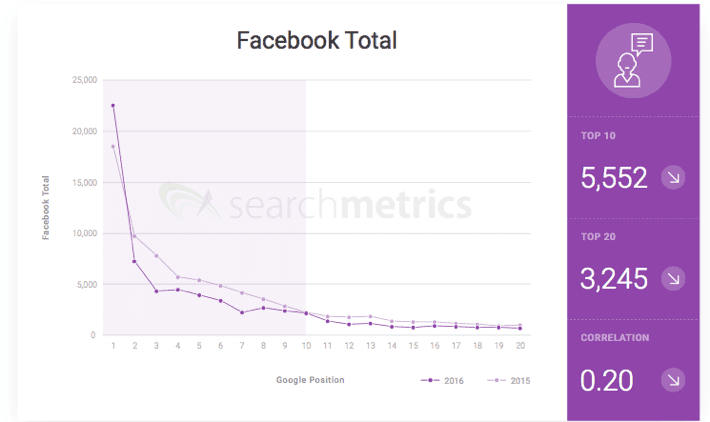
A recent post by Contently explains,
“As of 2017, links that held the first position on the first search results page for a given keyword were correlated with over twice as many social signals as the link ranked second.”
Data such as this suggests search engines could take social performance into account when ranking content.
7. Links and Authority
Measuring links will help you to gauge the traction your content is gaining. An inbound link—that you earned—is:
- An indicator you created cool content
- A traditional measure of SEO progress
A simple way to measure links is to setup a Talkwalker Alert, which will show you who mentioned (and maybe linked to) your content. You might want to make use of the information to reach out and say hello to the content creators and forge a new relationships.
Also, it’s helpful to watch your “Domain Authority” (DA), which tracks your link popularity and search ranking potential. Keep in mind DA may fluctuate over time. What really matters is your DA relative to your competitors in search results.
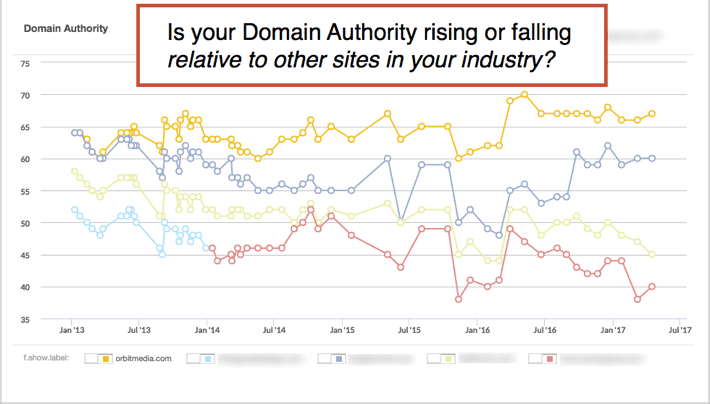
Check your DA (and your competitors’ DA), for free, using Link Explorer. Search pros tend to rely on the paid version of Moz to monitor relative DA. The number itself doesn’t matter as much as the gap between your DA and your competitors’—and which direction it’s going.
Want advanced tips on domain authority? Read this post on our blog.
8. Clickthrough rate (CTR)
If you master just one metric, make it this one. Marketers who earn high CTR will win regardless of the channel. CTR is the key success factor and the metric that rules them all.
Clickthrough rate is the percentage of visitors who…
- Click on your listing in a competitive search results page (SEO)
- Click on your post in a fast-flowing social media stream (social)
- Click on your email in a crowded inbox (email marketing)
Search marketers can find it in the Queries report mentioned above.
Email marketers can find it in the reports provided by email service providers.
Social media marketers (and advertisers) will need to dig into the analytics provided by individual networks or rely on social media metrics platforms.
9. Leads
Leads… hmm. What are they?
You’re going to want to define them. Generally speaking, though inbound marketers often give you permission to define something as non-committal as a download or email subscription as a lead, a lead is really something more.
“An email address is not a lead. A lead is someone who raised their hand and asked to be contacted about your services.” — Andy Crestodina
We already talked about subscriber growth, so let’s set that aside and look at leads as something greater:
- An event registration
- A request for a demo or consultation
- A free trial of your product
- A coupon download
The list could go on. A lead is really to be defined by the eyes of the beholder, if you will.
All that said, without incorporating marketing automation systems of CRM applications, you can easily measure and evaluate the conversion rates of your landing pages and factor what you learn into improving the quality of the content offered.
10. Feedback
“When people comment on your article, they bring additional information and content to the table, brainstorm ideas for new topics to write about, and strengthen your website. Comments even add to the words, keywords, and SEO value as seen by search algorithms.” — Neil Patel, from 7 Proven Strategies to Increase Your Blog’s Traffic by 206%
Yes, I’m veering a bit into a qualitative area here. I’m not proposing you “count” feedback figures, but do propose the feedback you receive counts and should be figured into your future content efforts.
Feedback to your content can come in a variety of ways, including:
- Social media updates/shares
- Direct social media messages
- Blog comments
- Phone calls
- Contact form submissions
- Reviews
The feedback you get via the media above will mostly be positive (if your content doesn’t suck). You’ll probably also get questions and a few requests mixed in. Once in awhile, you could get some constructive feedback, counter arguments, or even negative feedback.
It’s all good. Gathering and synthesizing feedback is part of the process of improving the quality of your content and optimizing its effectiveness, which is the reason I wrote this post.
For a variety of purposes, especially for getting started with measuring the effectiveness of your content marketing, easy means “doable.”
I want you to perpetually improve your content marketing. So I want you to do this stuff.
